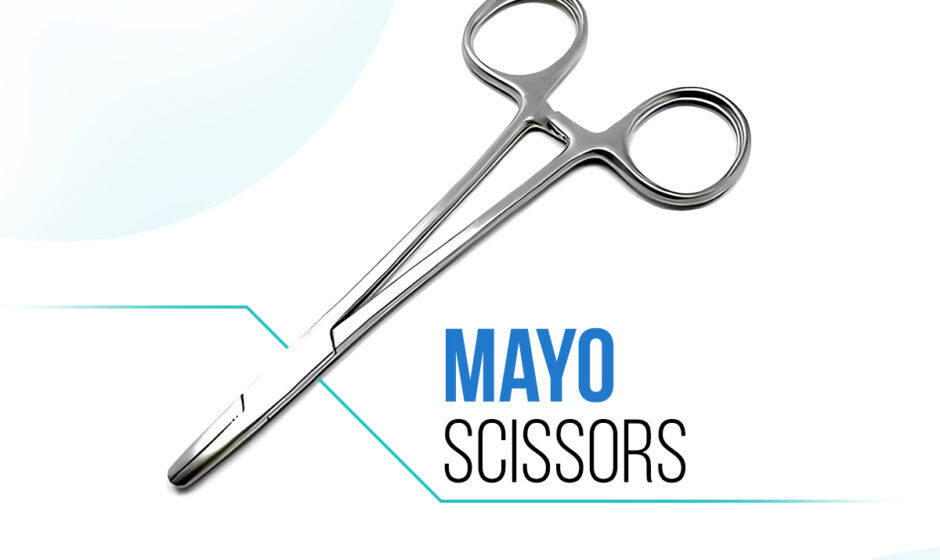Mayo scissors are a staple instrument in nearly every surgical setting. Known for their strength, durability, and versatility, these scissors are specially designed to cut and dissect body tissues during operations. Their reliable performance has made them essential in procedures ranging from general surgery to more specialized fields. Understanding the design and applications of Mayo scissors gives insight into why they are so widely trusted by surgical professionals around the world.
Design Features of Mayo Scissors
The design of Mayo scissors reflects their intended function: to cut through thick and fibrous tissue with precision. They are generally made of high-grade stainless steel, which ensures corrosion resistance, strength, and the ability to undergo repeated sterilization without losing quality. The blades are thick and robust, with a semi-blunt or blunt tip that allows for safe and controlled cutting.
Mayo scissors come in two primary blade types: straight and curved. The straight Mayo scissors are typically used for cutting sutures and surface-level tissues. Their straightforward design makes them suitable for shallow surgical fields. On the other hand, curved Mayo scissors have blades that arch upward, which helps in accessing and cutting deeper tissues. The curve allows for better visibility and maneuverability inside the body, especially in confined or sensitive areas.
Another notable design feature is the finger rings, which are shaped to offer comfort and control during extended use. This ergonomic structure allows the surgeon to perform delicate or forceful cuts with ease, reducing hand fatigue and enhancing surgical precision.
Curved Mayo Scissors and Their Role
Curved Mayo scissors play a key role in surgeries where deeper dissection is required. The curvature of the blades allows them to follow the natural contours of the human body. This is particularly helpful in abdominal, pelvic, and thoracic surgeries. The shape provides more visibility and access than straight scissors in tight spaces, making it easier to dissect or cut tissue layers without harming adjacent structures.
These scissors are commonly used for cutting thick, fibrous tissues like fascia, muscle, and other connective tissues. The curved design not only improves reach but also minimizes the need to reposition the tool frequently, which helps maintain efficiency during the procedure.
Understanding Mayo Dissecting Scissors
Mayo dissecting scissors are designed not just for cutting but also for performing blunt dissection. This is a surgical method where tissues are gently separated rather than sharply cut. The rounded or blunt tips of the scissors allow surgeons to push tissues apart, helping them access target areas while avoiding damage to vital structures like nerves and blood vessels.
This feature makes Mayo dissecting scissors especially useful in complex surgeries where precision is critical. By using the blunt tips, surgeons can minimize bleeding and trauma to surrounding tissues, which supports faster healing and reduces post-operative complications. These scissors are frequently used in abdominal surgery, soft tissue dissection, and procedures involving sensitive organs.
Applications Across Surgical Fields
Mayo scissors are not limited to one specialty—they are used in a wide range of surgical disciplines. In general surgery, they are employed to cut fascia, tissue, and sutures. In orthopedics, they handle the tough tissues around joints and bones. Gynecologists rely on curved Mayo scissors for procedures involving the uterus and ovaries, where deep pelvic access is required.
In plastic surgery, Mayo dissecting scissors are helpful for reshaping tissue and separating layers with precision. Neurosurgeons may use them in cranial or spinal procedures, where careful dissection is needed near nerves. Their versatility across these fields highlights the importance of choosing the correct blade shape and length for each specific surgical need.
Instrument Handling and Safety
Proper handling of Mayo scissors is essential to ensure patient safety and instrument longevity. Surgeons and operating room staff are trained to hold and maneuver the scissors with skill, allowing for controlled and deliberate cuts. The handle’s grip and the blade’s sharpness help prevent slippage or miscuts, which is crucial in avoiding complications during surgery.
The scissors should always be checked for alignment and sharpness before use. Dull blades can tear rather than cut tissue, leading to unnecessary trauma. Proper maintenance—including cleaning, sterilization, and inspection—is key to preserving the tool’s performance and hygiene standards.
Sizes and Material Options
Mayo scissors come in various lengths, typically ranging from 5.5 inches to 6.75 inches, to match different surgical needs and anatomical areas. Shorter versions offer more control, which is helpful for delicate work in smaller spaces. Longer scissors are ideal for reaching deep into the body without needing to widen the incision.
While stainless steel remains the standard material, some models are coated with tungsten carbide inserts. These inserts increase durability and maintain sharper edges for longer periods, reducing the frequency of sharpening or replacement. Other modern variations may include non-reflective finishes or lightweight designs that improve visibility and reduce hand fatigue.
Importance in Modern Surgery
In today’s operating rooms, time, accuracy, and safety are critical. Mayo scissors help meet these demands by providing dependable performance and ease of use. Whether a surgeon is cutting sutures, dissecting tissue, or navigating a deep surgical field, these scissors are designed to support the goal of a successful and smooth procedure.
Their continued use across different medical settings shows their lasting value. As surgical tools become more advanced, the basic yet effective design of Mayo scissors still holds its place. Upgrades in materials and ergonomic features have improved their performance, but their core purpose remains unchanged.
Conclusion
Mayo scissors are one of the most dependable tools in surgery, known for their strong design and wide range of applications. With options like curved Mayo scissors for deep cuts and Mayo dissecting scissors for gentle tissue separation, they serve the needs of many surgical fields. Their design offers comfort, precision, and strength, while their versatility allows them to be used in both routine and complex procedures.
Whether used in a simple suture removal or a complex abdominal operation, Mayo scissors continue to prove their worth as essential instruments in surgical care. Their well-thought-out design and trusted applications make them a fundamental part of safe and effective surgery.
More info: Artema Medical



